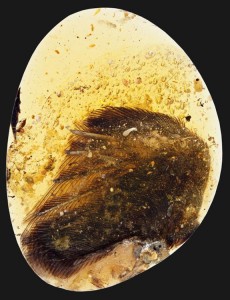Ancient Wings in Amber
July 19, 2016
Late last month, paleontologists (scientists who study fossils) announced an amazing discovery. Researchers led by Lida Xing at the China University of Geosciences in Beijing had discovered two bird wings preserved in amber. They published their findings in the journal Nature Communications.

Amber preserved this 100 million-year-old wing tip featuring bones, feathers, and soft tissue.
Credit: © Ryan C. McKellar, Royal Saskatchewan Museum
Amber is a hard, yellowish-brown fossilized resin. It comes chiefly from the resins of pine trees that grew millions of years ago. These resins were gummy materials mixed with oils in the trees. When the oils oxidized (combined with oxygen), hard resins were left. These pine trees were then buried underground or underwater, and the resins slowly changed into lumps of amber. These lumps often contain insects trapped as the resins flowed from the trees. But finding larger animals such as small vertebrates (animals with backbones) is incredibly rare. In the 1993 science fiction film Jurassic Park, dinosaur DNA (deoxyriboneucleic acid) is discovered in the blood of an ancient mosquito fossilized in amber. Movie scientists then used the DNA to recreate dinosaurs—an improbable, yet intriguing, plot line.
The wing fossil subjects of last month’s report were formed about 100 million years ago, in the Cretaceous Period, in what is now Myanmar (also called Burma). Two birds apparently became stuck in the sticky resin of a tree and died. The amber preserved the three-dimensional structure of the birds’ wings, as well as the wings’ feathers, skin, and bones—even the color patterns!
Xing and his team think the wings came from a group of birds called enantiornithines, which means opposite birds in Greek. These birds had claws and teeth, and they went extinct along with the nonflying dinosaurs about 65 million years ago. The fossils showed that the wings were from young birds and that the birds hatched as miniature adults, ready to fly. This is different from modern birds, which must develop for weeks or months before they can leave the nest.
The structure of the wings and the arrangement of feathers are similar to modern bird wings. Birds evolved (developed over time) about 150 million years ago from meat-eating dinosaurs, so they must have quickly developed modern-looking wings, before enantiornithines and the ancestors of modern birds split.
Unlike science fiction, these fossils won’t resurrect the extinct enantiornithines, even if they do contain DNA. The technology to create entire animals from bits of ancient DNA does not yet—and might never—exist. The fossils do, however, offer paleontologists a treasure trove of information that will help us better understand early birds and their world.


